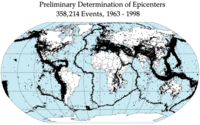
Photo from wikipedia
Abstract A 680-km long wide-angle seismic profile was acquired in the southwest continental margin (SWCM) of the South China Sea to better understand its crustal variation and continental extension. By… Click to show full abstract
Abstract A 680-km long wide-angle seismic profile was acquired in the southwest continental margin (SWCM) of the South China Sea to better understand its crustal variation and continental extension. By using two-dimensional forward ray-tracing, and joint refraction and reflection travel time inversion methods, velocity structures of the SWCM are yielded. The model results show a hyper-stretched continental crust with a thickness of 10–18 km, which is variable under sedimentary basins and reef areas. Compared with βwc, βuc, and βlc derived from the crustal thickness, the degree of the whole crust extension appears to be larger than that of the upper crust but lower than that of the lower crust, except for the model of 560–610 km. Thus, we infer that depth-dependent extension of the crust has occurred in the SWCM. High velocity bodies with velocities larger than 7.0 km/s are sporadically distributed in the lower crust, which might be related to the remnant Mesozoic arc that can be attributed to the subduction of the paleo-Pacific plate. The obvious low velocity anomaly with the maximum thinning crust below the boundaries of the Nansha Trough and Palawan-Borneo thrust wedge (PBTW) is interpreted as the frontal thrust of the PBTW.
Journal Title: Journal of Asian Earth Sciences
Year Published: 2020
Link to full text (if available)
Share on Social Media: Sign Up to like & get
recommendations!